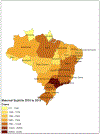Failure to recognize Low non-treponemal titer syphilis infections in pregnancy May lead to widespread under-treatment
- PMID: 33401033
- PMCID: PMC8012229
- DOI: 10.1016/j.ijid.2020.12.076
Failure to recognize Low non-treponemal titer syphilis infections in pregnancy May lead to widespread under-treatment
Abstract
Objectives: Rates of maternal syphilis have increased five-fold in Brazil in the past decade. While penicillin remains the only appropriate treatment for maternal syphilis, we hypothesized that low non-treponemal titers (<1:16) may lead to reduced penicillin treatment in Brazil.
Methods: Using Brazilian Ministry of Health data on women diagnosed with maternal syphilis between January 1, 2010, and December 31, 2018, we conducted a random-effects logistic regression model with a cluster correction at the state level to evaluate predictive factors of penicillin treatment.
Results: We observed yearly increases in cases of pregnant women with syphilis from 2010 to 2018. There was significant variation by state: 52,451 cases were reported in São Paulo, followed by 26,838 in Rio de Janeiro. Among 215,937 cases of maternal syphilis, 91·3% received penicillin. In the random-effects model, a non-treponemal titer ≥1:16 was associated with 1·44 higher odds of receiving penicillin (95% confidence interval [CI]: 1·391·48), and prenatal care was associated with a 2·12 increased odds of receiving penicillin (95% CI: 2·022·21). Although there is an association between the absence of prenatal care and inadequate treatment for syphilis, 83·2% of women in this cohort who did not receive penicillin were engaged in prenatal care.
Conclusions: Providers may inappropriately exclude low non-treponemal titers and thereby fail to use penicillin treatment in maternal syphilis. While the cause of the maternal syphilis epidemic in Brazil is multifactorial, we believe our findings can be used to develop targeted interventions throughout Brazil as well as shape public health initiatives globally.
Keywords: Brazil; Health policy; Penicillin; Pregnancy; Syphilis; Treatment.
Copyright © 2021 The Authors. Published by Elsevier Ltd.. All rights reserved.
Conflict of interest statement
Disclosure of relationships and activities
All authors declare no competing interests.
Figures


Similar articles
-
Neurosyphilis in Brazilian newborns: a health problem that could be avoided.Rev Inst Med Trop Sao Paulo. 2020 Nov 9;62:e82. doi: 10.1590/S1678-9946202062082. eCollection 2020. Rev Inst Med Trop Sao Paulo. 2020. PMID: 33174978 Free PMC article.
-
Syphilis in pregnancy in Tanzania. II. The effectiveness of antenatal syphilis screening and single-dose benzathine penicillin treatment for the prevention of adverse pregnancy outcomes.J Infect Dis. 2002 Oct 1;186(7):948-57. doi: 10.1086/342951. Epub 2002 Sep 3. J Infect Dis. 2002. PMID: 12232835 Clinical Trial.
-
The continuing threat of syphilis in pregnancy.Curr Opin Obstet Gynecol. 2016 Apr;28(2):101-4. doi: 10.1097/GCO.0000000000000258. Curr Opin Obstet Gynecol. 2016. PMID: 26871538 Review.
-
Syphilis during pregnancy: a preventable threat to maternal-fetal health.Am J Obstet Gynecol. 2017 Apr;216(4):352-363. doi: 10.1016/j.ajog.2016.11.1052. Epub 2016 Dec 9. Am J Obstet Gynecol. 2017. PMID: 27956203 Review.
-
Syphilis-attributable adverse pregnancy outcomes in China: a retrospective cohort analysis of 1187 pregnant women with different syphilis treatment.BMC Infect Dis. 2019 Mar 29;19(1):292. doi: 10.1186/s12879-019-3896-4. BMC Infect Dis. 2019. PMID: 30925908 Free PMC article.
Cited by
-
Ineffective penicillin treatment and absence of partner treatment may drive the congenital syphilis epidemic in Brazil.AJOG Glob Rep. 2022 May;2(2):100050. doi: 10.1016/j.xagr.2022.100050. Epub 2022 Feb 4. AJOG Glob Rep. 2022. PMID: 36081843 Free PMC article.
-
Increasing incidence rates of sexually transmitted infections from 2010 to 2019: an analysis of temporal trends by geographical regions and age groups from the 2019 Global Burden of Disease Study.BMC Infect Dis. 2022 Jun 26;22(1):574. doi: 10.1186/s12879-022-07544-7. BMC Infect Dis. 2022. PMID: 35754034 Free PMC article.
-
Maternal HIV and syphilis are not syndemic in Brazil: Hot spot analysis of the two epidemics.PLoS One. 2021 Aug 3;16(8):e0255590. doi: 10.1371/journal.pone.0255590. eCollection 2021. PLoS One. 2021. PMID: 34343219 Free PMC article.
-
Repercussions of the COVID- 19 pandemic on maternal and congenital syphilis in South Brazil: a time series analysis 2010-2022.BMC Infect Dis. 2025 Apr 15;25(1):528. doi: 10.1186/s12879-025-10901-x. BMC Infect Dis. 2025. PMID: 40234761 Free PMC article.
-
Patterns of pregnancy loss among women living with and without HIV in Brazil, 2008-2018.AJOG Glob Rep. 2022 Oct 17;2(4):100121. doi: 10.1016/j.xagr.2022.100121. eCollection 2022 Nov. AJOG Glob Rep. 2022. PMID: 36387295 Free PMC article.
References
-
- Boletim Epidemiológico Sífilis 2019. Departamento de Doenças de Condições Crônicas e Infecções Sexualmente Transmissíveis 2019. [Available from: http://www.aids.gov.br/pt-br/pub/2019/boletim-epidemiologico-sifilis-2019].
-
- Cambou M Are HIV and Syphilis Syndemic Among Pregnant Women in Brazil? Poster session presented at: 10th Annual IAS conference on HIV science; 2019. July 21–24; Mexico City, Mexico.
-
- Centers for Diseae Control and Prevention. Screening Recommendations: Clinician Timeline for Screening Syphilis, HIV, HBV, HCV, Chlamydia, and Gonorrhea 2019. [Available from: https://www.cdc.gov/nchhstp/pregnancy/screening/clinician-timeline.html].
MeSH terms
Substances
Grants and funding
LinkOut - more resources
Full Text Sources
Other Literature Sources
Medical
Miscellaneous

